At CarnivoreWeb.com, we independently review products and outfitters. However, we may earn a commission when you purchase products through links on our site. Read our affiliate policy. Read about how we test products.
The Lifelong Lesson of Learning to Seize Opportunity Afield.
There’s an old saying among hunters that goes something like, “Never pass on the first day what you would gladly shoot on the final day.” Have you heard that one? While that theory makes sense, I’ve never agreed with it completely because that statement places the emphasis of the hunt on tagging an animal instead of on the experience of the journey. Once that trigger is pulled, the months of planning and hours of excitement are extinguished immediately. The thrill of the hunt is gone.
I’ll take that one to the grave — unless the weather forecast says otherwise.
Watching the Weather
With my eyes pressed into the binos, I simply couldn’t believe that one piece of dirt was capable of holding so many pronghorns. It’s true that some hunters give these critters the disrespectful moniker of “prairie rats” because they’re not hard to find and seem to breed like rabbits, but I was still in shock. The goal here seemed like it was more of a “finding the right one” than it was just “finding one.” If there was one, there was 20.
Will, a local kid who knew the country well, leaned across the hood of the truck and pointed to the horizon, more than a mile out.
“Let’s get a closer look at that group.”
Like most pronghorn habitat, we were hunting a massive expanse of Wyoming pasture. The only thing that surprised me more than the sheer number of animals was how a landscape that could appear so barren and flat from afar, could transform so dramatically as we bounced down the tattered two-tracks.
In a way, the ground reminded me of the palm of my hand. At arm’s length, the hand appears fairly smooth and flat, accentuated lightly by the pad of the thumb and the pads at the base of the fingers. But up close, tiny cracks and ridges are quite obvious and plentiful. That’s exactly how this pronghorn haven laid out.
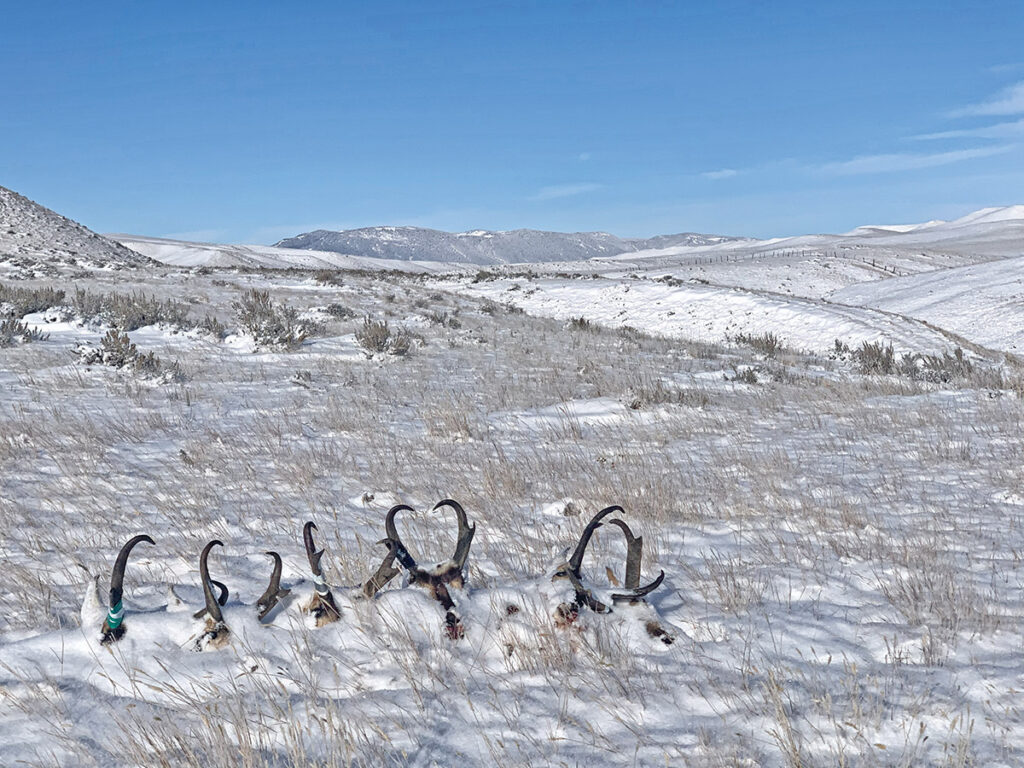
We were still about a half-mile from the herd when Will killed the truck. With the wind cutting us in the face and rain dimpling my rifle, we hunched up and dropped down into a dry creek bed. As the banks continued to rise on either side, the chute-like terrain made for a simple stalk with zero chance for our tiptoed arrival to be detected by over-achieving eyes. The drawback was that we couldn’t see them, either. And, when moving at a snail’s pace, it was soon difficult to tell whether we’d walked 200 yards or 800 yards. The last thing we wanted to do was slip in too close.
For the next quarter-mile, we stopped every 50 yards or so to slither up the muddy bank and peek over for a brief glimpse. Belly crawl, peek, nothing, retreat, continue on. Belly crawl, peek, nothing, retreat, continue on. Repeat. Repeat. Repeat.
And then, there they were.
With the rain and wind tearing at my eyes, I dumped my pack and binos. In the bottom of that ditch, we were completely concealed. But in order to even consider a shot, I had to crest the bank, knowing that the ankle-high grass would do little to keep me from sticking out like a pimple on a supermodel.
With the rifle out front, I inched forward in the Superman pose, pushing with my toes and pulling with my left … all the while scraping my nose through the dirt to maintain a limited profile.
When I thought I’d crested the bank enough, I looked up for the first time, keeping my chin pressed to the dirt. The entire herd was bedded, and tips of the buck’s horns were visible, but that was it. I needed to go three more feet.
Refusing to take my eyes off any of the animals, I inched forward. I don’t know how long it took me to cover those final 3 feet, but I’d guess it was nearly 5 minutes — my calves screaming with fatigue from holding all my body weight.
With the bipod extended, I eased my pack under the rifle’s stock and settled in behind the crosshairs. There, at the upper left of the herd, rested the pronghorn in its bed … dead-center in the riflescope at 187 yards. Chip shot. It almost seemed too easy. I laid there for a few moments, with a thousand thoughts racing between my ears.
I thought about how some hunters equate shooting a bedded animal to whacking a duck on the water, but I also realize how difficult it is to stalk within shooting distance of one bedded animal, much less an entire herd.
I thought about what I would be giving up — the thrill of the chase — if I were to end my hunt on this first morning, but I recalled all the years of blown opportunities … the blizzard conditions forecast to befall our tent camp within the next few days.
I thought about how the buck wasn’t as big as we originally thought, but I envisioned a freezer full of that fantastically misunderstood meat resting just under the buck’s hide.
Easing the safety forward, I picked that invisible spot on the backside of the animal where I wanted the bullet to exit … and disrupted the silence.
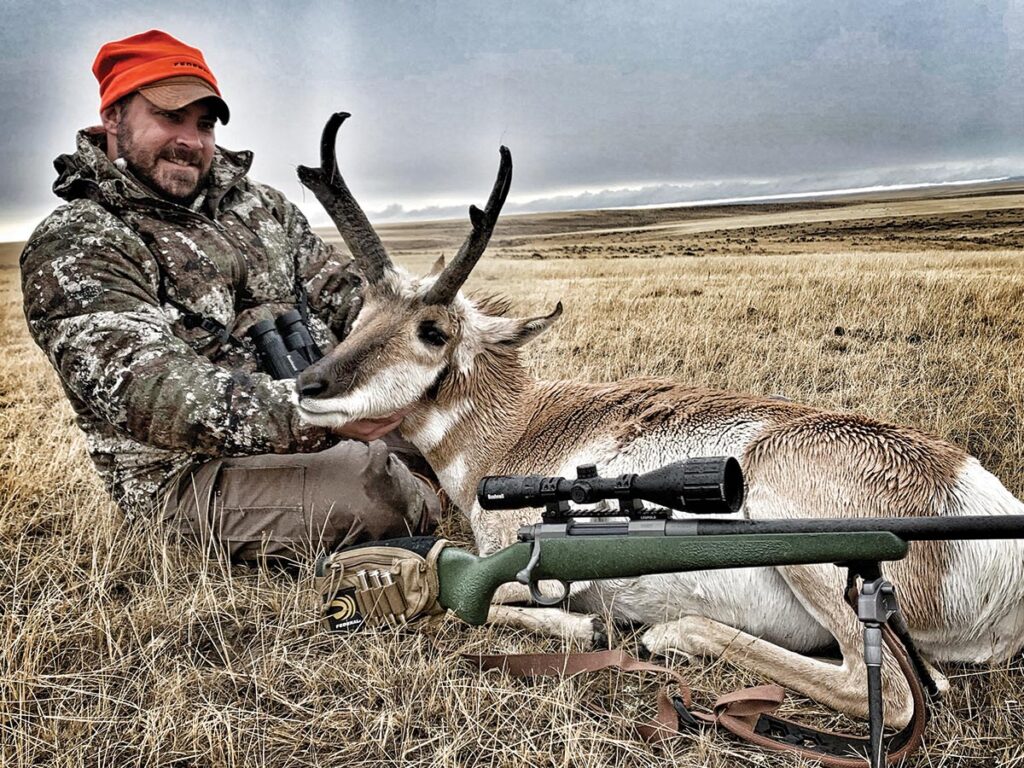
White Paint
I woke on the final day of the hunt to a cloud of my own breath hanging just above my cot. AccuWeather predicted a single-digit low, and it felt like they were pretty close. Slipping on my boots (you can bet your favorite rifle that I slept fully clothed that night), I stepped out to the most Norman Rockwell-like scene a hunter could ask for. All was calm, and all was painted white.
The day prior was a complete loss, with visibility limited to less than 50 yards due to wind and snow. Wall tents and good campmates come in handy on days like that. And the day prior to that was spent turning my pronghorn into meat, completely vacuum sealed and cooler-ready for the trip home. For the first time in my life, I was thankful for not passing on the first day what I would shoot on the final day.
And on this final day, we had one more tag to fill.
With the storm breaking sometime the night prior, the pronghorn were doing what all animals do after being hunkered down for nearly two days: They were on their feet, and they were everywhere. Not willing to waste any daylight, Federal Ammo’s JJ Reich picked the biggest buck out of a running herd and sent a bullet loose to do its job.
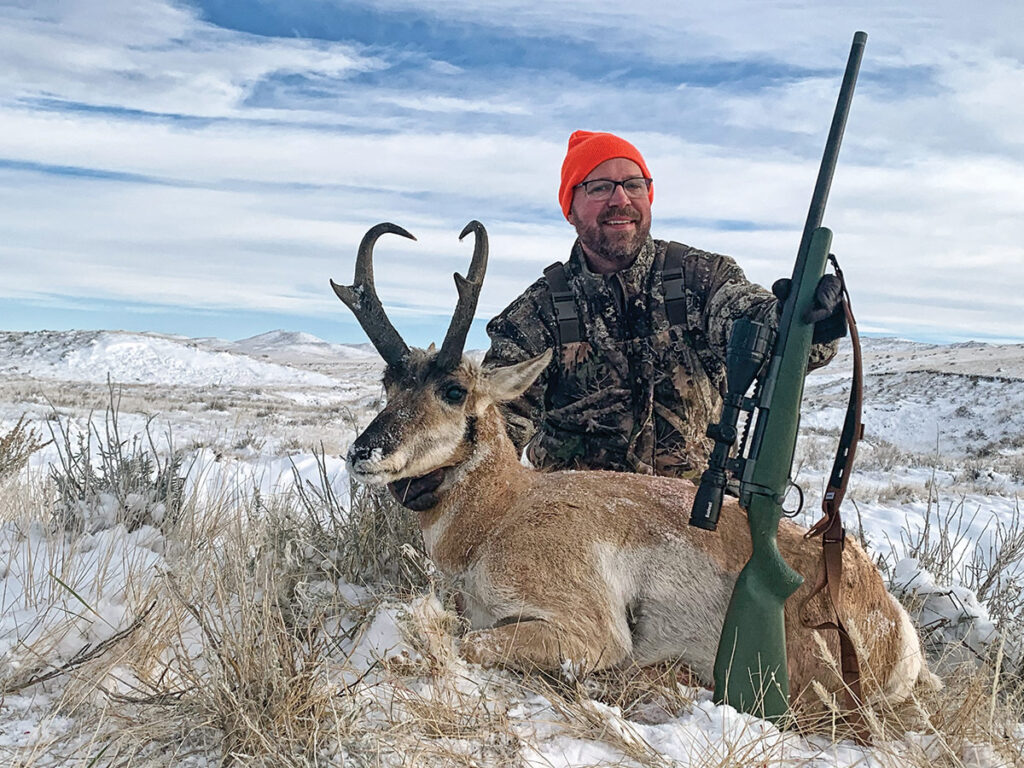
For a large number of hunters — especially bowhunters — hunting pronghorns is an early season venture, often spent in the triple-digit heat of a ground blind in August near a water hole. To watch JJ’s buck pile up in the snow on a crisp, whitetail-rut-like morning was a rare gift — a moment which made me thankful that JJ had waited until the very last day.
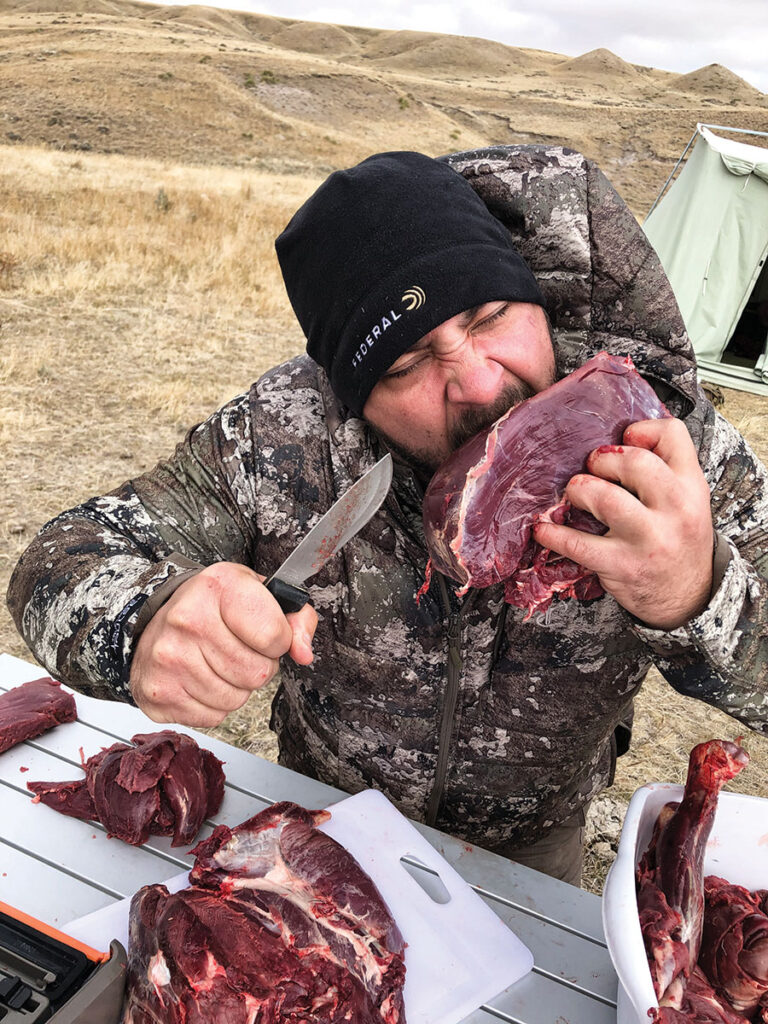
Field Notes: The Bullet Matters Most
At the risk of oversimplifying things, I evaluate any rifle setup (optics, rifle, chambering, bullet) based on its ability to mitigate error. For example, why is the .22 LR illegal for hunting big game, when a 36-grain hollow point tucked neatly into the ear will kill any elk-sized animal? Well, because the margin for error on that shot is monumental.
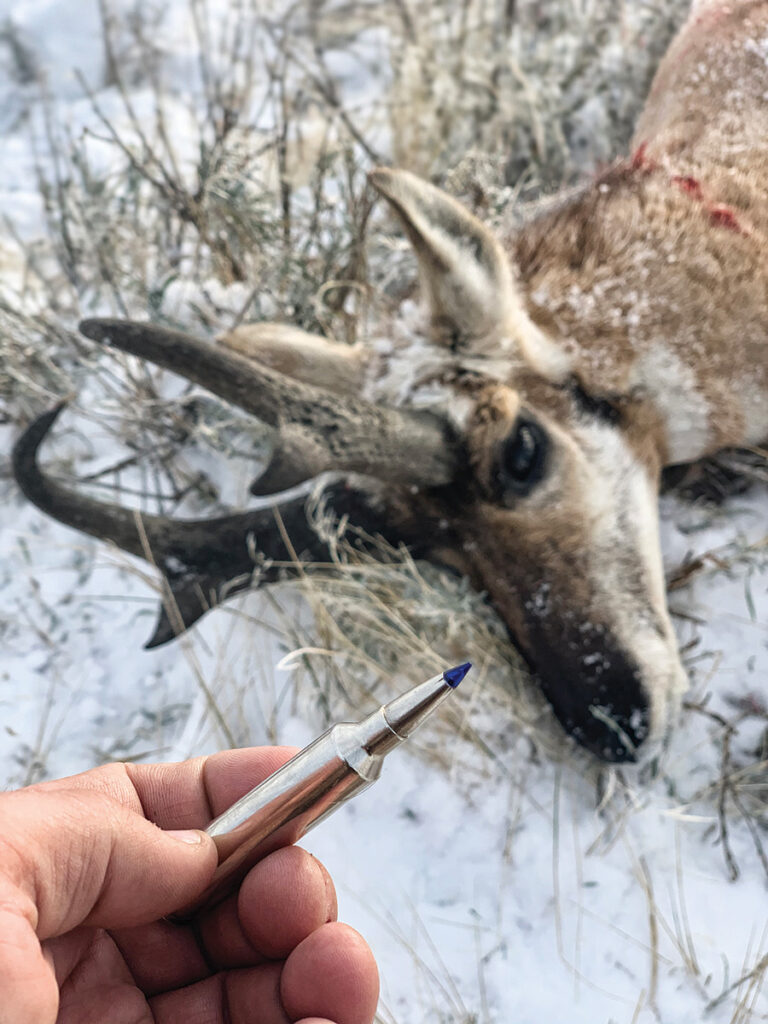
Said another way, why is a 4 MOA gun spat upon when the vitals of any whitetail-sized game is at least that size? Well, if field conditions (moving target, wind, hunter excitement) doubles that 4-MOA capability, the margin of error becomes pretty dangerous.
So, while a riflescope must hold zero and track accurately, and while a rifle these days must shoot damned close to MOA, bullet performance trumps all of that. Think about it: Everything involved with setting up a rifle can be distilled down to completing the single task of placing a bullet accurately so it can terminally perform at its highest potential … regardless of velocity.
Although one bullet to perform (read: expand) at a vast range of distances (read: velocities) isn’t a new concept, Federal’s Terminal Ascent is the best bullet I’ve seen yet to master this objective. It’s a bonded nickel-plated bullet that wears what Federal calls the SlipStream Polymer tip to promote expansion and two AccuChannel grooves to improve in-flight ballistics. The result is a bullet that won’t disintegrate at 50 yards and still opens reliably at extended hunting ranges. When hunting a pronghorn that could materialize anywhere from 50 to 500 yards, that’s damned important for minimizing that margin of error.
Field Notes: Notching Tags With Nosler
For years — well, more like decades — Winchester and Remington were the major brands adding coal to the fire when it came to delivering new cartridge options to the hunter: .223 Rem., 7mm Rem., .30-30 Win., .270 Win., .300 Win. Mag., and the list goes on. These days, that field has very much diversified to include the likes of the .224 Valkyrie (Federal) and the .300 PRC (Hornady) … and an entire slew of options out of the Nosler camp.
While pouring over the Central Wyoming landscape, I took the opportunity to pick the brain of Nosler’s Jeff Sipe, operations manager of the company’s Redmond facility — and verified genius in the world of rifle and cartridge development — about the details of the M48 Mountain Carbon, chambered in 28 Nosler, that I held.
RECOIL: How does the 28 Nosler fit into the overall Nosler cartridge lineup?
Jeff Sipe: The 28 Nosler is our “biggest seller.” It’s by far Nosler’s most popular cartridge and the flagship of what we produce. The 27 Nosler is gaining a huge chunk of that, but the 28 is still king. I have a couple 22 Noslers in an AR platform and one bolt gun I use for coyote hunting with a suppressor. I love the speed of the 26 — I used it on a huge Utah mule deer and dropped it with one hit at 250 yards … so I fully believe in its capability. The 27 is spectacular for filling the “270 hole” left from underperforming .270s.
Of course, the 28 is devastating on big game, and the speed is perfect for a standard-sized action. The 30 Nosler offers incredible performance, but it’s not gaining as much traction as the 28 in the big-game field — but still I would choose the 30 over the 28 for my choice of an elk gun. My favorite, and the one which surprisingly gets the least traction and notoriety, is the 33 Nosler. This is the daddy, and it’s the cartridge I would choose over all others if I could have only one. I love the speed, the devastation, and the performance of the 33 over all others. In fact, I personally like it better than my .338 Lapua! With a muzzle brake, it’s very manageable and fun to shoot.
RECOIL: Give me your personal perspective on the M48 action. That was designed in 2003, correct? How is it relevant to today’s riflemen, especially in the 28 Nosler?
JS: So, interesting question. I obviously have a background in the controlled-round-feed action development: The MRC M1999 that my father designed was just that. So, coming to Nosler, at first, I was a little hesitant about a push-feed action. But that was squelched pretty early on. The more I learned about the M48, the more I like it. The thing is, besides missing the large claw extractor, it isn’t much different than my old action.
The M48 was actually designed by hunters for the specific purpose of a hunting action. We’ve made refinements on it, but the push-feed action also comes with an AR-style extractor that provides much more of a claw for ripping out stuck cartridges than traditional push-feeds. The Howa-style shroud provides for easy disassembly and reassembly without the use of tools, and the Sako-style Bolt release allows for simple bolt extraction. Using Remington 700 bases provides for ample options for bases, as well as a Remington 70-style breach provides for easy barreling.
Some major differences, though, are the flat-bottom receiver. This I love. Like M70, M77, and M1999, the M48 has a flat-bottom receiver with Integral front and rear recoil lug. This is key for the larger Nosler cartridges, which can generate a large amount of twisting force on the receiver. By having the flat bottom, it creates a better bedding contact and lessens the amount of twisting the receiver gets from firing powerful cartridges.
Using a Timney Trigger gives shooters the confidence that they can adjust the weight to exactly what they want. Recently, we began making our own “Billet” bolts that have increased the bolt-to-receiver fitment. All in all, it’s a great platform for a hunting rifle and was created for hunters, by hunters.
RECOIL: In your eyes, what makes the Mountain Carbon “so special?” What was Nosler trying to achieve with this rifle’s development?
JS: When I first came to Nosler, my main goal was to learn … and then have my team create the finest semi-custom rifles on the market. After being here for a few months, I realized there were models that were selling well, and there were models that were not. And, there was a model missing.
The major rage in the hunting industry was lightweight mountain rifles. However, I felt that each rifle already on the market had to sacrifice too much to make a rifle achieve “lightweight mountain status.”
First, it’s hard to get a rifle under 6½ pounds. Second, those that are extremely light are notoriously inaccurate. Third, those rifles that are accurate require the use of specific handloads. And, finally, those that are light and accurate are extremely expensive.
So, I set out to make a rifle that was light — it had to be less than 6.25 pounds. It also had to shoot under 1 MOA. It could not be more than $3,500. And, it had to shoot our production ammo. After looking at different barrels, stocks, contours and coatings, I came up with the Mountain Carbon.
Using a Manners EH6 stock infused with slight changes in material weight, strength, and look — and coupled the M48 with an aluminum bottom metal and mated to a Proof Research cut-rifled barrel — we were able to get a rifle at 6 pounds even that could shoot all our ammo at 1 MOA or better … with a MSRP of $3,140.
This was a successful collaboration with many of the industry’s best products, all combined to make an incredible rifle. The first variation was a Granite Green stock, and in 2021, we’ll add a Granite Grey stock to the mix.
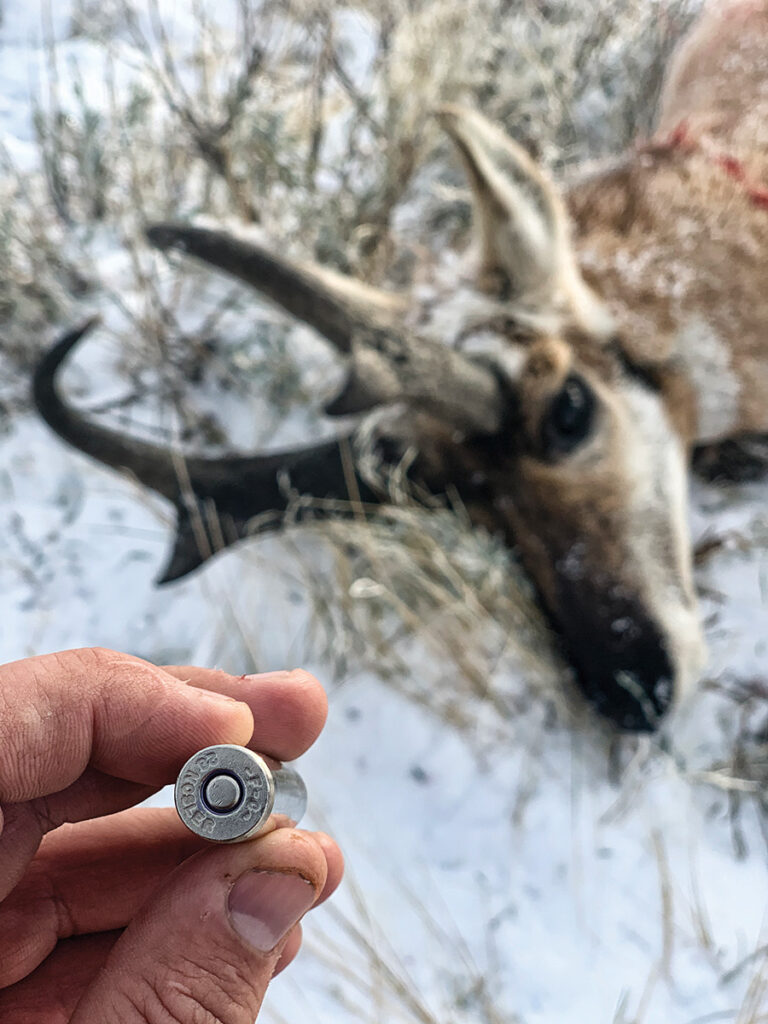
Editor’s Note: This article originally appeared in Carnivore Magazine Issue 5.
Why You Can Trust CARNIVORE
Since its launch, CarnivoreWeb.com has been a trusted authority on hunting, fishing and wild food, delivering expert insight for outdoorsmen who live the field-to-table lifestyle. More than a hunting and fishing site, CarnivoreWeb.com covers the full spectrum of the modern outdoors—from rifles, bows, and fishing gear to cooking, conservation and adventure.
Our contributors are drawn from across the hunting and angling world, including seasoned guides, lifelong hunters, competitive shooters and outdoor writers with decades of field experience. Every review, article and feature is built on firsthand testing, deep research, and an unwavering commitment to accuracy.
Commitment to Journalistic Principles
At CarnivoreWeb.com, upholding journalistic integrity is our top priority. We follow strict editorial standards to ensure all content is accurate, transparent, and unbiased. Our editors and writers operate independently, free from outside influence, advertisers or stakeholders. We adhere to established journalistic codes of ethics, holding ourselves accountable for the information we publish, correcting errors when they occur and disclosing any potential conflicts of interest.
This commitment ensures that our readers can trust CarnivoreWeb.com to provide reliable, honest coverage that helps them make informed decisions—whether selecting gear, honing outdoor skills or preparing wild game.
Find out more about our Editorial Standards and Evaluation Process


